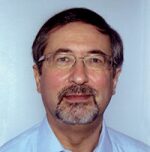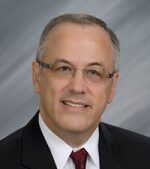A condensed version of what is on the minds of SPE’s technical directors is: The industry needs multidisciplinary, data-driven ways to adapt to what is ahead, focus on what is critical for decision making, and take a long view as another generation takes over.
In other words, this group of six representing key industry disciplines has a lot of ideas. When SPE’s technical directors met in October 2013, they discussed two big ideas that may become group projects: better management of critical processes to ensure they are done safely, and caring for aging fields.
A discussion of whether managing aging fields is worthy of greater attention brought up the challenge of permanently plugging offshore wells not designed with current technology in mind, whether worn tubulars in old wells can withstand the stress of life-extending fracture treatments, and estimating how long a well is likely to be producing.
“It crosses disciplines. There are problems, and opportunities to get more out of fields, that cross the lines,” said Roland Moreau, SPE technical director for Health, Safety, Security, Environment, and Social Responsibility, who has taken a personal interest in process safety.
Smarter, faster use of data is a common theme. David Curry, SPE technical director for Drilling and Completions, wants to see drilling systems that are wired to manage the data needed to observe what is ahead and intelligently respond to it. Olivier Houzé, SPE technical director for Reservoir Description and Dynamics, sees the need for better systems to highlight critical bits of information from all the data flowing in as more sensors are built into wells.
Shauna Noonan, SPE technical director for Production and Operations, is interested in better long-term production management of unconventional wells. Her concern overlaps Houzé’s work on predicting reservoir life for unconventional wells because “part of the plan is for retirement, but how do you do that when you do not know what the retirement age is?”
When it comes to petroleum engineering educators, the average retirement age is uncomfortably close for two‑thirds of those in academia. The academic crew change comes at a time when there has been a surge in the number of students enrolled, putting stress on institutions that are struggling to keep up. Cindy Reece, SPE technical director for Management and Information, said SPE needs to actively foster new ideas and greater cooperation between academia and industry to ensure a quality education for future petroleum engineers. “When we look at what is needed in the future, what we have today is not sustainable,” Reece said.
Shauna Noonan, SPE Technical Director, Production and Operations

Not Fade Away
When SPE’s technical directors discussed managing aging oil and gas facilities, one question was: What do you call it? Plugging and abandonment has long been used, but the word “abandonment” sends a negative message to those living around those wells, and the directors want to make the point that the issues go well beyond permanently sealing old wells. Other possible labels include managing mature assets; fields nearing the end of their life; or restoration, since the procedure restores natural barriers where a well once flowed.
Noonan said there needs to be more thought about the end from the beginning. As with saving and investing for retirement, decisions made early on can have a profound impact decades later. This is particularly true for a generation of unconventional wells, because the cost of early miscalculations can be magnified by the tens of thousands that are being mass produced each year.
“The industry needs to think about how these wells will be produced years down the road as they near retirement,” Noonan said. “This is not a problem to be handed over to the production engineers once the well is drilled and completed.” Well design decisions affect the cost and effectiveness of pumping systems, flow performance, and well intervention capabilities.
Long-term monitoring could be used to extend the life of a field, but the decision to install that costly hardware when the well is completed needs to be made during planning. “For the unconventional well developments, a multidisciplinary team of drilling, completions, production, and reservoir engineers needs to map out an overall strategy of the entire well life cycle,” Noonan said.
The team’s vision needs to extend to the end of the well’s life, when it will need to be permanently plugged. She said those building wells now need to answer the question “Are current drilling and completing practices leading us down a path that would make wellbore retirement a technical challenge?”
Even small decisions can have a lasting impact. Noonan would like to see greater use of “management of change” systems, which are used in industries such as aerospace to observe and control daily decisions. These systems are widely used to track maintenance work on major processing equipment used on the surface, such as gas processing units, and Noonan said “that needs to be done below the wellhead.”
Olivier Houzé, SPE Technical Director, Reservoir Description and Dynamics

Telling Details
The exploding number of sensors in wells offers reservoir engineers the opportunity to understand reservoirs as never before, if they only had the time to understand it all.
For Houzé, there is opportunity in this irony. The biggest challenge has moved from creating computer systems capable of filtering enormous volumes of data from sensors to developing smart software that ensures meaningful information is not missed. Doing so will require new analytical methods that identify trends in data, point out anomalies worth further attention, and provide data-based forecasts. “What is common to the three items is that they all aim at saving an engineer’s time, which is the main, if not only, way to address information overload,” Houzé said.
The overload is the product of the growing number of wells with long-term monitoring systems, such as pressure sensors. This is likely to increase exponentially with the use of equipment such as fiber optic cables capable of measurements throughout the wellbore. A notable exception is unconventional formations, where the industry is still lacking quality data. Compounding the problem is the rise in wells per engineer as companies develop drilling-intensive onshore formations.
“The number of potentially significant recorded events has inflated to the point where it is absolutely impossible for the engineers to treat them all,” Houzé said. He offered several responses to the challenge:
- Refine computerized field management work flows so engineers can focus on instances where the observed data diverges from what was predicted.
- Revisit artificial intelligence, which fell out of favor after the 1990s, to create programs that constantly monitor well data, presenting engineers with problems likely to require creativity and the ability of humans to deal with events that fall outside the norm.
- Use models based on big data, rather than physics, to detect trends, spot outliers, and even provide draft forecasts.
“These systems let the data (production, logs, etc.) constrain a physics-less model that only honors the observed behavior,” Houzé said.
While the most enthusiastic supporters of this modeling approach argue that reservoir data-only production forecasts are the future, Houzé sees them as a near-term option, but not the final word. “All these technologies are meant to save time and streamline information,” he said. “The final word has to be with well-trained engineers using models honoring the physics. If you only rely on automatic physics-less processes, be ready for billion-dollar cyberblunders.”
David Curry, SPE Technical Director, Drilling and Completions

Detect and React
Adaptive well construction is not a familiar concept, but anyone who drives a new car has likely benefited from it. In driving and drilling, systems are able to use a rapid flow of data to react to changing conditions, such as the way antilock brakes adjust to force applied to them on a wet road.
“Many parts of the control systems in modern cars are adaptive,” said Curry, who recently helped organize an SPE forum to explore adaptive drilling and completion systems. “As you drive, you are in ignorant bliss of the incredible control system under you. If you turned it all off, you would appreciate how much it is doing to look after you.”
Adaptive systems have been developed to speed drilling by using downhole data to adjust the weight-on-bit and rotary speed to reduce vibration. But the oil industry lags behind the automobile industry in using them. “Driverless motor cars are capable in tests of navigating safely along busy highways, so why can’t we do the same with our wells?” Curry said.
Reaching that goal will require better spatial awareness. One of the best known examples of adaptive well construction is geosteering, which guides the drillbit using petrophysical data showing where it is in relation to geological structures mapped during planning. “But with sensors typically 30 to 90 ft behind the bit, and current mud pulse telemetry rates, it’s a bit like trying to steer down the highway at 70 mph by looking in the rearview mirror,” Curry said.
“The challenge is knowing where you are geologically,” he said. “There are many things you could be doing better with a better knowledge of the environment you are drilling into.”
A key to reaching that state of knowledge is creating an electronic nervous system that provides a detailed picture of what is ahead based on drilling data gathered closer to the bottom of the hole, which is linked to a control system capable of intelligently responding to what is observed.
Doing so will require integrated systems with communication links that allow a wider range of sensors to transmit more data faster to control systems programmed to make the correct adjustments as conditions change.
Drillers will still be able to intervene when needed, but there was a discussion at the forum about how to define their role and how best to manage interaction between humans and future control systems.
“We have some of the technologies for adaptive well construction now,” Curry said. “We can look out 10 to 20 years to technological capabilities we would like to have and how we could use those to revolutionize how we drill wells.”
Howard Duhon, SPE Technical Director, Projects, Facilities, and Construction

What Were They Thinking?
Oilfield facilities engineering mixes precise analysis based on math and logic with the mental habits, psychology, and social skills of people in large organizations. Technical skills are obviously important, but so are soft skills.
Duhon is interested in both sides of the process. The level of difficulty in project management is rising along with the scale and complexity of the jobs, as well as the number of parties with a stake in the outcome. “The mission for the industry in the projects, facilities, and construction area is more effective project execution, more effective community engagement, and continuous improvement in process safety,” Duhon said.
He has been busy expanding the information and training available for members within the discipline. There will be more how-to articles in SPE’sOil and Gas Facilities magazine, which serves the discipline. A new SPE technical section is being formed bringing together those involved in flow assurance issues, adding to what is offered by the Separation Technology and Water Handling technical sections. Looking ahead, he sees the need for similar attention to issues related to compressors.
When he looks at design, construction, and operations, Duhon also sees the need for greater awareness about what goes into engineering decisions. His work as a facilities engineer offers regular reminders that in this objective profession, with precise formulas used to define what needs to be done, there is a human element that adds a level of subjectivity.
Duhon’s interest in the messy process of how decisions really are made led to his first involvement in SPE committees. He began his study of decision making with objective systems, such as decision trees and linear programming. Over time Duhon has focused more on the social and psychological aspects of how decisions are made One goal is to make project managers aware of decisions they do not even notice they are making. “The invisible two-thirds of the iceberg is decision making,” Duhon said.
“There are explicit decisions—when you choose what type of compressor to install—where it is clear you are making decisions,” he said. “But most of our decisions are tacit—most do not realize they are making a decision when they do an analysis just like they did it on the last project.”
Roland Moreau, SPE Technical Director, Health, Safety, Security, Environment, and Social Responsibility

In Process
The SPE Board of Directors is considering ways to focus more on process safety. The challenge in that is deciding which processes merit close attention. Moreau, who has been an advocate for a greater focus on process safety, likened the challenge to consuming a pie: “We cannot eat it all at one time. We need to break it into chunks.”
To gather input, Moreau used SPE Connect to ask members to share their process safety concerns and he received responses from around the globe. They suggested issues from safely integrating large systems to planning for how to properly execute an emergency shutdown. The goal is to choose the initiatives and programs that improve how the industry analyzes its operations to identify and reduce risks.
The push to expand process safety efforts comes at a busy time in this discipline. An SPE summit in March will consider how best to calculate worst-case discharge from offshore wells. United States regulators asked SPE to take a second look at the issue, which its members first considered in the wake of the Macondo disaster in the US Gulf of Mexico.
Those general guidelines have guided operators preparing the estimates that must be submitted in permit applications for drilling in the US Gulf of Mexico. The US Bureau of Ocean Energy Management asked for a second, more detailed look, because it was concerned about the wide variations in some worst-case discharge estimates.
An SPE subcommittee is working on a more specific estimation method to calculate the size of a worst-case oil discharge using probabilistic analysis. The goal is an SPE- recommended method—a formula plus examples for how it can be applied in different circumstances. A proposal under development will be reviewed by an invitation-only group of experts from industry, academia, and regulators.
Growing use of chemicals for exploration and production led to plans for a workshop on chemical risks this year. Proper chemical management is a challenge for some companies in the industry, particularly those without specialized professionals on staff.
A July 2012 SPE summit looking at human factors in operational safety will yield a white paper. Moreau said there is also interest in starting a human factors technical section. And he is looking for member input for HSE Now,the SPE online periodical for what is new, interesting, and on the minds of professionals in the field.
Cindy Reece, SPE Technical Director, Management and Information

The Other Crew Change
To explain why she is concerned about the future of petroleum engineering education, Reece starts with a simple chart. It shows that the number of petroleum engineers expected to graduate in the next couple years is near the peak reached in the early 1980s when the industry was booming.
The problem in that good news is that in between the highs then and now is a deep U-shaped valley. The chart, based on an annual survey by Lloyd Heinze, a petroleum engineering professor at Texas Tech University, shows the number of petroleum engineering graduations falling rapidly after the oil boom ended and oil companies began cutting jobs. The curve turned steeply up in 2005 when companies began hiring large number of engineers to prepare for the big crew change, as many key workers near retirement. Colleges, which downsized during lean times, have been unable hire teachers fast enough to keep up with rising enrollments. The number of students per faculty members jumped from less than 15:1 in 1993 to near 55:1 in 2013.
This shift has put a heavy load on the professors, many of whom are nearing retirement age. More than two‑thirds of petroleum engineering faculty members in the US universities surveyed are older than 50, and 37% of them are past age 60. While similar statistics are not available outside the US, academics from other countries at a recent SPE forum on the future of petroleum engineering education, said they face similar problems, Reece said.
SPE’s Board recently recognized the critical nature of this issue when it made attracting, developing, and retaining petroleum engineering faculty a strategic initiative. To support this effort, the organization committed USD 600,000 a year to recognize faculty who use innovative teaching techniques and those who are successful at attracting people into an academic career. The program also helps new faculty members establish research programs.
It is a positive step, but Reece said the problem is far larger. There is a wide pay gap between academia and industry—a petroleum engineer with a bachelor’s degree can often earn more than an assistant professor with a PhD—which steers students away from seeking advanced degrees and entering academia.
Another area of need is industry support for young academics so they can do the research needed to publish papers. Overcrowded laboratories need to be expanded and updated with the latest equipment.
“What we are finding is that the issues are so complex, no one company or no one university has the ability to really solve them,” Reece said. It will require collaboration among academia, which SPE is working to facilitate. SPE’s role is to promote programs that address specific issues and facilitate collaboration to spread the use of good ideas, she said.
One promising possibility is a cooperative program among universities to open up wider access to classes and equipment among students in participating institutions. Another would be to have petroleum engineering experts loaned by companies to teach in their area of expertise.
Other ideas include creating online networks that promote sharing of course-related material, and using advanced communications to allow students at one school to remotely use automated laboratory equipment elsewhere.
Regional pilot programs in Nigeria and the northeastern US are currently under way to better understand regional differences, because the problems vary, as will likely solutions. Reece said, “It is not going to be one thing. It will be a lot of things.”


